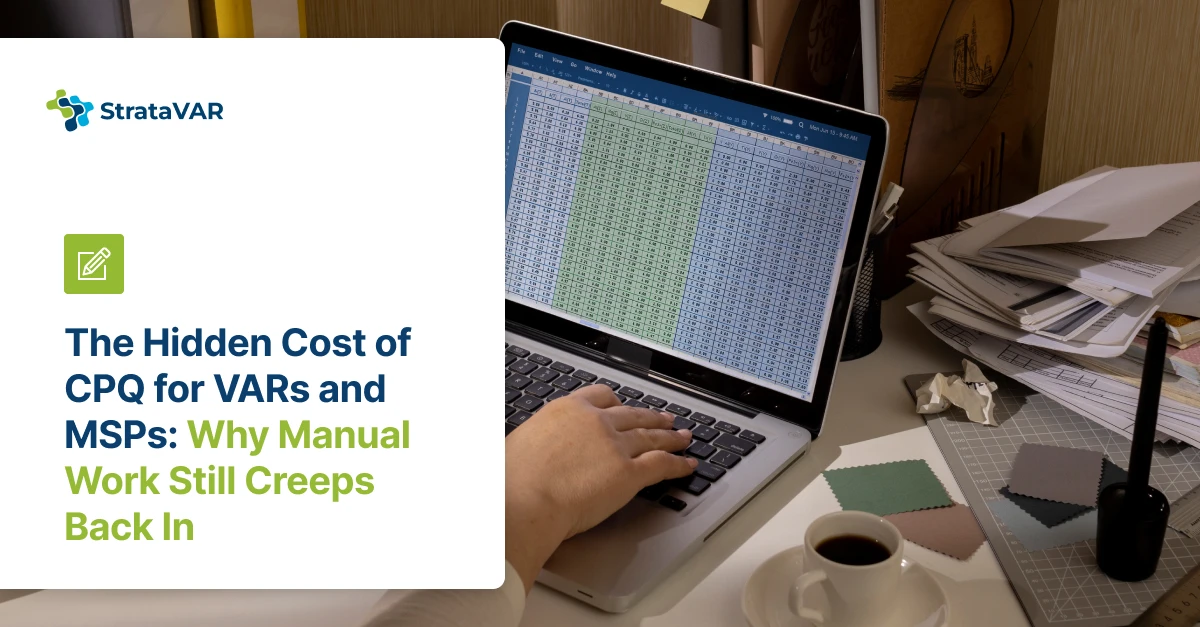It’s All in the Numbers: How VARs Can Calculate Their CPQ’s ROI

This is a div block with a Webflow interaction that will be triggered when the heading is in the view.
This is a div block with a Webflow interaction that will be triggered when the heading is in the view.
VARs often operate in environments prone to inefficiencies and time waste. With multiple quotes, iterative processes, and a high risk of manual errors, quoting can become a significant bottleneck.
The Need for Resellers to Perform CPQ ROI Analysis
Efficient quoting directly impacts a VAR’s success by improving win rates, customer satisfaction, and overall profitability. Therefore, understanding and optimizing the return on investment (ROI) of quote automation is crucial for VARs as it helps quantify the benefits of automation relative to their costs.
The Economic Impact of a Quotation Software for VARs
Implementing automated quoting drives two main economic benefits for value-added resellers:
- Increased Revenue: Faster time-to-quote and greater accuracy and scalability translate into higher revenues. More revenue allows VARs to “do more”—expand their business, invest in new opportunities, and enhance their competitiveness in the market.
- Reduced Costs: By eliminating errors and improving efficiency, automated quoting solutions minimize the time spent by technical teams and sales reps on time-consuming details.
How to Calculate ROI on Quote Automation for Resellers
VARs traditionally work with partially—or fully—manual quoting processes. When considering the return on investment on a quote application for resellers, compare the following three parameters:
1. Revenue/Profitability
- Annual Revenue: Assess the organization’s yearly turnover.
- Average Deal Size: Understand the typical size of deals to estimate revenue impact.
- Win Rate: Determine how many deals are successfully closed out of the total quotes provided.
- Average Product Margin: Analyze profit margins to estimate the financial impact of automated quoting.
2. Efficiency
- Number of Sales Reps: Calculate how many sales reps are involved in the quoting process.
- Quoting Time per Deal: Measure the total time spent by technical teams and back-office per quote.
- Sales Cycle Length: Assess how many full-time employees are required to support the current quoting process.
3. Quality
- Current Quoting Accuracy: Assess how accurate the current quoting process is.
- Order Error Rate: Evaluate the percentage of orders containing errors to estimate the financial impact of inaccuracies.
Questions for Internal Assessment: VAR CPQ Return on Investment
As the next step toward estimating potential ROI for any quote automation tool, each reseller should take the time necessary to internally assess its quoting process. While efficiency (#2) is the easiest to calculate as it is linked to headcount, correctly assessing profitability (#1) and quality (#3) will significantly affect efficiency as well.
Below, we have compiled a list of questions to help VARs assses the economic impact of a VAR quoting software. Included as well are benchmarks that StrataVAR has calculated from years of experience in this space.
First, consider the number of quote iterations that occur each month and how frequently quotes need to be refreshed. This will offer insight into both the operational burden and the potential for improvement. Additionally, assess whether the value of each quote is factored into ROI assessments. A failure to account for quote value can skew ROI projections and lead to an underestimation of potential gains.
For resellers, another critical factor that affects the CPQ’s ROI is the contribution of Value Incentive Program (VIP). For example, a VAR with an annual Cisco turnover of $50M could see an increase in profitability from $2M (4%) to $3.5M (7%) annually through automation. This can represent a significant profitability boost, as VIP could account for up to 7% of annual revenue.
Personnel time reduction, particularly in sales and operations, should also be examined. By reducing the time required for quotes, VARs can potentially win more deals and increase revenue. An analysis of current win rates and the impact of automation – which can lead to a 20% improvement in these rates – can provide further insights.
In addition, evaluate the cost of errors, as error rates in manual quoting processes range from 5% to 10%. Quantifying the cost savings that come from reducing these errors can significantly contribute to the reseller’s ROI from the CPQ solution.
Finally, consider the value of trust in customer relationships. Improved accuracy in quotes and the addition of features like delivery tracking and serial number management can enhance the customer experience, and thereby foster trust. This trust can lead to future sales, with an estimated 5% increase in revenue due to the stronger customer relationships formed through automation.
Best Practice Examples for Reseller CPQ ROI Calculation
To understand the importance of VARs focusing on ROI, we’ve highlighted some examples from our vast experience working closely with VARs:



